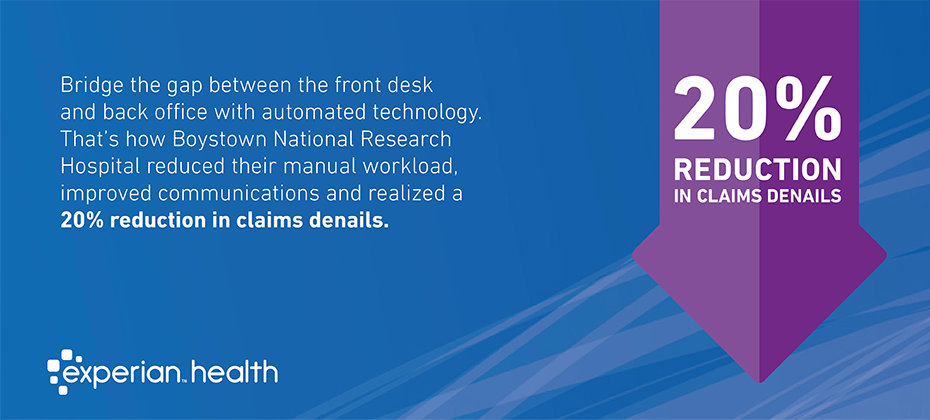
About 8 percent of the costs involved in U.S. healthcare are spent on administrative costs. Whether it’s paperwork for a simple follow-up or processing billing for a complex surgical procedure, the costs add up immensely for healthcare organizations.
It’s a problem that Boys Town National Research Hospital knew well, according to Toni Gross, Director of Patient Financial Services.
A few years ago, Boys Town Hospital staff realized they had a front-office team that was doing a lot of manual work, which was causing claims denials. The back-office team was largely focused on fixing the denials, but not communicating with the front-office staff about the common mistakes being made to avoid the denials in the first place.
“The approach just wasn’t efficient,” said Gross. “We were on a vicious cycle. Lots of denials, repeating work, repeating work, so I just stopped and finally looked at the process.”
Of all the claims healthcare providers submit, 5 to 10 percent are denied, costing providers billions in the process each year. And above all, it puts pressure on a team that could be handling other tasks. It’s one of the many reasons providers like Boys Town Hospital need to overhaul their revenue cycle management metrics.
Boys Town Hospital wanted to connect the front-office and back-office teams so they could focus on what really mattered: Decreasing denials and getting paid as quickly as possible.
The importance of automated software
But how can busy providers fulfill their mission when they’re faced with these revenue cycle management challenges? Boys Town Hospital needed an automated solution to get their organization on track.
Because the front-office team had been separated from the rest of the process, they were not getting any feedback on their work. They were spending all of their time checking eligibility, and handling scheduling and registering.
To reduce denials, the front-office needed a way to financially clear accounts upfront. They also needed an intelligent work queue to identify and present only those patients who need follow up by staff in order to be cleared prior to arrival, minimizing the hands-on work that bogs down operations.
Boys Town Hospital decided to implement technology that could automate up to 80 percent of their pre-registration activities. While the back-office team took the lead in implementing the technology, both teams started working together to make sure they were aligned in how to reduce claims denials.
In 2017, only a year after going live, Boys Town Hospital saw a 20 percent reduction in eligibility denials and eliminated all of their manual work.
“The key to success was thinking about the entire revenue cycle,” Gross said. “Experian Health’s many tools fit together to make the process seamless. Also, it’s important to get things right from the beginning.”
The team built as many edits as possible to avoid problems. When new problems come along, more edits can be inserted to avoid them moving forward.
“I call it backing up the bus,” said Gross. “There’s a problem; you’re presented with it; back up the bus. Where did it start? How can I avoid it?”
Automating the processes mean that staff only touch the claims that that will cause problems on the back end. This increases staff focus because they are not handling the same tasks repeatedly.
Work smarter, not harder
Healthcare revenue cycle management is a challenge — but implementing automated software can be a game changer.
“I am a support to physicians. I am a support to nurses. I want my phone to ring when they have a question about anything,” said Gross “It’s my part to step over into their world, listen to them, and figure out what it is that I can do to try to make that a little bit better for them. That’s how I make the patient experience better.”



